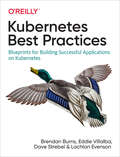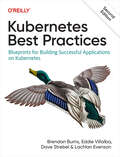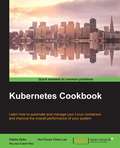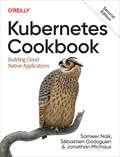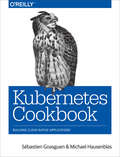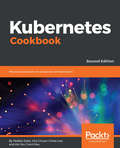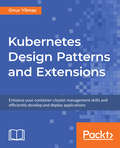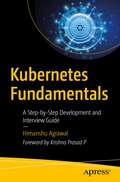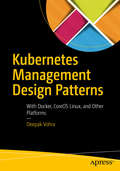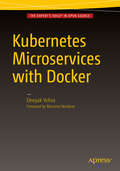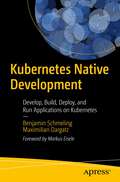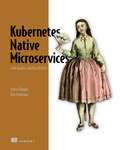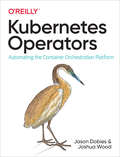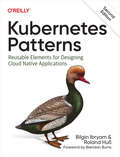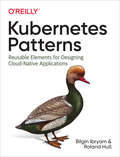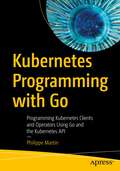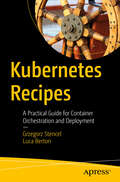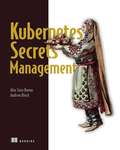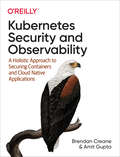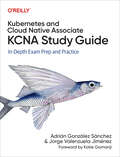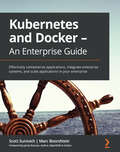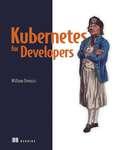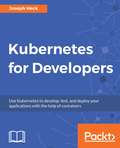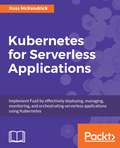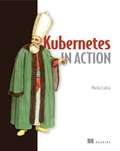- Table View
- List View
Kubernetes Best Practices: Blueprints for Building Successful Applications on Kubernetes
by Brendan Burns Eddie Villalba Dave Strebel Lachlan EvensonIn this practical guide, four Kubernetes professionals with deep experience in distributed systems, enterprise application development, and open source will guide you through the process of building applications with this container orchestration system. Based on the experiences of companies that are running Kubernetes in production successfully, many of the methods are also backed by concrete code examples.This book is ideal for those already familiar with basic Kubernetes concepts who want to learn common best practices. You’ll learn exactly what you need to know to build your best app with Kubernetes the first time.Set up and develop applications in KubernetesLearn patterns for monitoring, securing your systems, and managing upgrades, rollouts, and rollbacksUnderstand Kubernetes networking policies and where service mesh fits inIntegrate services and legacy applications and develop higher-level platforms on top of KubernetesRun machine learning workloads in Kubernetes
Kubernetes Best Practices: Blueprints for Building Successful Applications on Kubernetes
by Brendan Burns Eddie Villalba Dave Strebel Lachlan EvensonIn this practical guide, four Kubernetes professionals with deep experience in distributed systems, enterprise application development, and open source will guide you through the process of building applications with this container orchestration system. They distill decades of experience from companies that are successfully running Kubernetes in production and provide concrete code examples to back the methods presented in this book.Revised to cover all the latest Kubernetes features, new tooling, and deprecations, this book is ideal for those who are familiar with basic Kubernetes concepts but want to get up to speed on the latest best practices. You'll learn exactly what you need to know to build your best app with Kubernetes the first time.Set up and develop applications in KubernetesLearn patterns for monitoring, securing your systems, and managing upgrades, rollouts, and rollbacksIntegrate services and legacy applications and develop higher-level platforms on top of KubernetesRun machine learning workloads in KubernetesEnsure pod and container securityUnderstand issues that have become increasingly critical to the successful implementation of Kubernetes, such as chaos engineering/testing, GitOps, service mesh, and observability
Kubernetes Cookbook
by Hui-Chuan Chloe Lee Ke-Jou Carol Hsu Hideto SaitoLearn how to automate and manage your Linux containers and improve the overall performance of your system About This Book * Are you using containers in your organization and want to better manage, scale, and orchestrate apps on the container? Use the recipes in the book to find a reliable solution from experts * This is the first and only book on the market on Kubernetes, and it will show how to manage your containers in production using Kubernetes * Buy this book, simply follow the recipes, and you will be the master of your Linux containers Who This Book Is For The book is aimed at system administrators who have intermediate level of knowledge with Kubernetes and want to better manage their applications deployed over containers. Also, it will help those administrators who want to maintain and scale applications on these containers. What You Will Learn * Get to know how to build your own container cluster * Deploy and manage highly scalable applications using Kubernetes * Discover how to build high availability Kubernetes clusters * Find out how to build a continuous delivery pipeline for your application * Track metrics and logs for every container running in your cluster * Streamline the way you deploy and manage your applications with large-scale container orchestration In Detail Kubernetes is Google's solution to managing a cluster of containers. Kubernetes provides a declarative API to manage clusters while giving us a lot of flexibility. This book will provide you with recipes to better manage containers in different scenarios in production using Kubernetes. We will start by giving you a quick brush up on how Kubernetes works with containers along with an overview of the main Kubernetes features such as Pods, Replication Controllers, and more. Next, we will teach you how to create Kubernetes cluster and how to run programs on Kubernetes. We'll explain features such as High Availability Kubernetes master setup, using Kubernetes with Docker, and orchestration with Kubernetes using AWS. Later, will show you how to use Kubernetes-UI, and how to set up and manage Kubernetes clusters on the cloud and bare metal. Upon completion of this book, you will be able use Kubernetes in production and will have a better understanding of how to manage your containers using Kubernetes. Style and approach This recipe-based book precisely teaches you how to use Kubernetes in production and how to better manage your containers using Kubernetes.
Kubernetes Cookbook: Building Cloud Native Applications
by Sébastien Goasguen Sameer Naik Jonathan MichauxKubernetes is the de facto standard for container orchestration and distributed applications management across a microservices framework. With this practical cookbook, you'll learn hands-on Kubernetes recipes for automating the deployment, scaling, and operations of application containers across clusters of hosts.In this fully updated second edition, Sameer Naik, Sébastien Goasguen, and Jonathan Michaux from TriggerMesh provide a problem-solution-discussion format with easy lookups to help you find the detailed answers you need—fast. Kubernetes lets you deploy your applications quickly and predictably, so you can efficiently respond to customer demand. This cookbook delivers the essential knowledge that developers and system administrators need to get there.Recipes in this cookbook focus on:Creating a Kubernetes clusterUsing the Kubernetes command-line interfaceManaging fundamental workload typesWorking with servicesExploring the Kubernetes APIManaging stateful and non-cloud-native appsWorking with volumes and configuration dataCluster-level and application-level scalingSecuring your applicationsMonitoring and loggingMaintenance and troubleshooting
Kubernetes Cookbook: Building Cloud Native Applications
by Sébastien Goasguen Michael HausenblasKubernetes is becoming the de-facto standard for container orchestration and distributed applications management across a microservices framework. With this practical cookbook, you’ll learn hands-on recipes for automating the deployment, scaling, and operations of application containers across clusters of hosts.The book's easy-lookup problem-solution-discussion format helps you find the detailed answers you need—quickly. Kubernetes lets you deploy your applications quickly and predictably, so you can efficiently respond to customer demand. This cookbook, ideal for developers and system administers alike, provides the essential knowledge you need to get there. You’ll find recipes for :Kubernetes installation, Kubernetes API, API groups, Application primitives, Monitoring Troubleshooting
Kubernetes Cookbook: Practical solutions to container orchestration, 2nd Edition
by Hui-Chuan Chloe Lee Ke-Jou Carol Hsu Hideto SaitoLearn how to automate and manage your containers and reduce the overall operation burden on your system.Key FeaturesUse containers to manage, scale and orchestrate apps in your organizationTransform the latest concept of Kubernetes 1.10 into examplesExpert techniques for orchestrating containers effectivelyBook DescriptionKubernetes is an open source orchestration platform to manage containers in a cluster environment. With Kubernetes, you can configure and deploy containerized applications easily. This book gives you a quick brush up on how Kubernetes works with containers, and an overview of main Kubernetes concepts, such as Pods, Deployments, Services and etc. This book explains how to create Kubernetes clusters and run applications with proper authentication and authorization configurations. With real-world recipes, you'll learn how to create high availability Kubernetes clusters on AWS, GCP and in on-premise datacenters with proper logging and monitoring setup. You'll also learn some useful tips about how to build a continuous delivery pipeline for your application. Upon completion of this book, you will be able to use Kubernetes in production and will have a better understanding of how to manage containers using Kubernetes.What you will learnBuild your own container clusterDeploy and manage highly scalable, containerized applications with KubernetesBuild high-availability Kubernetes clustersBuild a continuous delivery pipeline for your applicationTrack metrics and logs for every container running in your clusterStreamline the way you deploy and manage your applications with large-scale container orchestrationWho this book is forThis book is for system administrators, developers, DevOps engineers, or any stakeholder who wants to understand how Kubernetes works using a recipe-based approach. Basic knowledge of Kubernetes and Containers is required.
Kubernetes Design Patterns and Extensions: Enhance your container-cluster management skills and efficiently develop and deploy applications
by Onur YilmazMaster the art of container management with Kubernetes and study robust container orchestration to ensure that your container-based applications sail into production without hiccupsKey FeaturesImplement best practices in cloud-native applications using KubernetesExplore the usage of client libraries and programmatic access to Kubernetes Use your domain expertise to codeBook DescriptionBefore plunging into how Kubernetes works, this book introduces you to the world of container orchestration and describes the recent changes in application development. You'll understand problems that Kubernetes solves and get to grips with using Kubernetes resources to deploy applications. In addition to this, you'll learn to apply the security model of Kubernetes clusters.Kubernetes Design Patterns and Extensions describes how services running in Kubernetes can leverage the platform's security features. Once you've grasped all this, you'll explore how to troubleshoot Kubernetes clusters and debug Kubernetes applications. You also discover how to analyze the networking model and its alternatives in Kubernetes, and apply best practices with design patterns.By the end of this book, you'll have studied all about using the power of Kubernetes for managing your containers.What you will learnUnderstand and classify software designs as per the cloud-native paradigmApply best practices in Kubernetes with design patternsSet up Kubernetes clusters in managed and unmanaged environmentsExplore Kubernetes extension pointsExtend Kubernetes with custom resources and controllers Integrate dynamic admission controllersDevelop and run custom schedulers in KubernetesAnalyze networking models in KubernetesWho this book is forKubernetes Design Patterns and Extensions is for you if you are interested in configuring and troubleshooting Kubernetes clusters and developing microservices-based applications on Kubernetes clusters. DevOps engineers with basic knowledge of Docker will also find this book useful. It is assumed that you are comfortable using command-line tools and programming concepts and languages.
Kubernetes Fundamentals: A Step-by-Step Development and Interview Guide
by Himanshu AgrawalExplore the world of Kubernetes and learn the concepts needed to develop, deploy, and manage applications on this container orchestrator. This step-by-step development guide is designed for application developers and support members aiming to learn Kubernetes and/or prepare for interviews. All the concepts in the book are presented in Q&A format, with questions framed exactly the way they are asked in an interview, giving you a distinctive edge in interviews.You’ll start by understanding how application development and deployment have evolved over the decades leading up to containerization. You’ll then dive deep into core Kubernetes concepts, learning Kubernetes architecture, Kubernetes objects and workload resources, and how to exploit them to their full potential. You’ll also learn Kubernetes deployment strategies and concepts related to rollout and rollback.Moving on, you’ll look at two very important aspects of any computing ecosystem: networking and storage. You will gain an understanding of access control in Kubernetes and how to manage a Kubernetes cluster using probes, resource quotas, taints, and tolerations. You will also get an overview of Docker and review Docker and Kubernetes best practices. Finally, you will learn about the kubectl command line tool.What You Will LearnLearn about basic and advanced Kubernetes objects and workload resourcesMaster important concepts such as namespaces, selectors, annotations, and access controlUnderstand the Kubernetes networking and storage systemManage a Kubernetes cluster with the help of probes, resource quotas, limits, and taintsWho This Book Is For Application developers and technical managers—both on the development and support sides, beginner and intermediate Kubernetes practitioners and aspirants, and those preparing for Kubernetes interviews.
Kubernetes Management Design Patterns
by Deepak VohraTake container cluster management to the next level; learn how to administer and configure Kubernetes on CoreOS; and apply suitable management design patterns such as Configmaps, Autoscaling, elastic resource usage, and high availability. Some of the other features discussed are logging, scheduling, rolling updates, volumes, service types, and multiple cloud provider zones. The atomic unit of modular container service in Kubernetes is a Pod, which is a group of containers with a common filesystem and networking. The Kubernetes Pod abstraction enables design patterns for containerized applications similar to object-oriented design patterns. Containers provide some of the same benefits as software objects such as modularity or packaging, abstraction, and reuse. CoreOS Linux is used in the majority of the chapters and other platforms discussed are CentOS with OpenShift, Debian 8 (jessie) on AWS, and Debian 7 for Google Container Engine. CoreOS is the main focus becayse Docker is pre-installed on CoreOS out-of-the-box. CoreOS: Supports most cloud providers (including Amazon AWS EC2 and Google Cloud Platform) and virtualization platforms (such as VMWare and VirtualBox) Provides Cloud-Config for declaratively configuring for OS items such as network configuration (flannel), storage (etcd), and user accounts Provides a production-level infrastructure for containerized applications including automation, security, and scalability Leads the drive for container industry standards and founded appc Provides the most advanced container registry, Quay Docker was made available as open source in March 2013 and has become the most commonly used containerization platform. Kubernetes was open-sourced in June 2014 and has become the most widely used container cluster manager. The first stable version of CoreOS Linux was made available in July 2014 and since has become one of the most commonly used operating system for containers. What You'll Learn Use Kubernetes with Docker Create a Kubernetes cluster on CoreOS on AWS Apply cluster management design patterns Use multiple cloud provider zones Work with Kubernetes and tools like Ansible Discover the Kubernetes-based PaaS platform OpenShift Create a high availability website Build a high availability Kubernetes master cluster Use volumes, configmaps, services, autoscaling, and rolling updates Manage compute resources Configure logging and scheduling Who This Book Is For Linux admins, CoreOS admins, application developers, and container as a service (CAAS) developers. Some pre-requisite knowledge of Linux and Docker is required. Introductory knowledge of Kubernetes is required such as creating a cluster, creating a Pod, creating a service, and creating and scaling a replication controller. For introductory Docker and Kubernetes information, refer to Pro Docker (Apress) and Kubernetes Microservices with Docker (Apress). Some pre-requisite knowledge about using Amazon Web Services (AWS) EC2, CloudFormation, and VPC is also required.
Kubernetes Microservices with Docker
by Deepak VohraStart using Kubernetes in complex big data and enterprise applications, including Docker containers. Starting with installing Kubernetes on a single node, the book introduces Kubernetes with a simple Hello example and discusses using environment variables in Kubernetes. Next, Kubernetes Microservices with Docker discusses using Kubernetes with all major groups of technologies such as relational databases, NoSQL databases, and in the Apache Hadoop ecosystem. The book concludes with using multi container pods and installing Kubernetes on a multi node cluster. What You Will Learn Install Kubernetes on a single node Set environment variables Create multi-container pods using Docker Use volumes Use Kubernetes with the Apache Hadoop ecosystem, NoSQL databases, and RDBMSs Install Kubernetes on a multi-node cluster Who This Book Is For Application developers including Apache Hadoop developers, database developers and NoSQL developers.
Kubernetes Native Development: Develop, Build, Deploy, and Run Applications on Kubernetes
by Benjamin Schmeling Maximilian DargatzBuilding applications for Kubernetes is both a challenge and an opportunity—a challenge because the options and complexity to develop for Kubernetes are evolving rapidly, an opportunity because, if done right, your applications will go into production quicker, scale easier, and run smoother.This book outlines the impact of Containers and Kubernetes on modern software development and discusses the application frameworks to pick from, how to design an application, and how to develop for and on Kubernetes. You are guided through the application life cycle: development, build, and deployment into the runtime phase. In each phase, you see how it ties to Kubernetes and how to leverage its manifold capabilities. Applications will be more lightweight, easier to maintain, and simpler to operate by just focusing on the business logic. This book provides a strong technical foundation in modern software development and operations. Practical examples show you how to apply the concepts and teach you the full potential of Kubernetes. What You Will LearnGet hands-on experience developing, building, and deploying software to KubernetesDevelop your software to get the best out of KubernetesFocus on business logic while leveraging Kubernetes servicesDesign application components of different granularity from application server-based services to lightweight servicesAutomate deployments and Day 2 operations Who This Book Is ForDevelopers who want to close the gap between development and the production environment in order to gain high delivery performance in terms of throughput and stability. This book also targets application operations and DevOps engineers.
Kubernetes Native Microservices with Quarkus and MicroProfile
by Ken Finnigan John ClinganBuild fast, efficient Kubernetes-based Java applications using the Quarkus framework, MicroProfile, and Java standards.In Kubernetes Native Microservices with Quarkus and MicroProfile you&’ll learn how to: Deploy enterprise Java applications on Kubernetes Develop applications using the Quarkus runtime Compile natively using GraalVM for blazing speed Create efficient microservices applications Take advantage of MicroProfile specifications Popular Java frameworks like Spring were designed long before Kubernetes and the microservices revolution. Kubernetes Native Microservices with Quarkus and MicroProfile introduces next generation tools that have been cloud-native and Kubernetes-aware right from the beginning. Written by veteran Java developers John Clingan and Ken Finnigan, this book shares expert insight into Quarkus and MicroProfile directly from contributors at Red Hat. You&’ll learn how to utilize these modern tools to create efficient enterprise Java applications that are easy to deploy, maintain, and expand. About the technology Build microservices efficiently with modern Kubernetes-first tools! Quarkus works naturally with containers and Kubernetes, radically simplifying the development and deployment of microservices. This powerful framework minimizes startup time and memory use, accelerating performance and reducing hosting cost. And because it's Java from the ground up, it integrates seamlessly with your existing JVM codebase. About the book Kubernetes Native Microservices with Quarkus and MicroProfile teaches you to build microservices using containers, Kubernetes, and the Quarkus framework. You'll immediately start developing a deployable application using Quarkus and the MicroProfile APIs. Then, you'll explore the startup and runtime gains Quarkus delivers out of the box and also learn how to supercharge performance by compiling natively using GraalVM. Along the way, you'll see how to integrate a Quarkus application with Spring and pick up pro tips for monitoring and managing your microservices. What's inside Deploy enterprise Java applications on Kubernetes Develop applications using the Quarkus runtime framework Compile natively using GraalVM for blazing speed Take advantage of MicroProfile specifications About the reader For intermediate Java developers comfortable with Java EE, Jakarta EE, or Spring. Some experience with Docker and Kubernetes required. About the author John Clingan is a senior principal product manager at Red Hat, where he works on enterprise Java standards and Quarkus. Ken Finnigan is a senior principal software engineer at Workday, previously at Red Hat working on Quarkus. Table of Contents PART 1 INTRODUCTION 1 Introduction to Quarkus, MicroProfile, and Kubernetes 2 Your first Quarkus application PART 2 DEVELOPING MICROSERVICES 3 Configuring microservices 4 Database access with Panache 5 Clients for consuming other microservices 6 Application health 7 Resilience strategies 8 Reactive in an imperative world 9 Developing Spring microservices with Quarkus PART 3 OBSERVABILITY, API DEFINITION, AND SECURITY OF MICROSERVICES 10 Capturing metrics 11 Tracing microservices 12 API visualization 13 Securing a microservice
Kubernetes Operators: Automating the Container Orchestration Platform
by Jason Dobies Joshua WoodOperators are a way of packaging, deploying, and managing Kubernetes applications. A Kubernetes application doesn't just run on Kubernetes; it's composed and managed in Kubernetes terms. Operators add application-specific operational knowledge to a Kubernetes cluster, making it easier to automate complex, stateful applications and to augment the platform. Operators can coordinate application upgrades seamlessly, react to failures automatically, and streamline repetitive maintenance like backups.Think of Operators as site reliability engineers in software. They work by extending the Kubernetes control plane and API, helping systems integrators, cluster administrators, and application developers reliably deploy and manage key services and components. Using real-world examples, authors Jason Dobies and Joshua Wood demonstrate how to use Operators today and how to create Operators for your applications with the Operator Framework and SDK.Learn how to establish a Kubernetes cluster and deploy an OperatorExamine a range of Operators from usage to implementationExplore the three pillars of the Operator Framework: the Operator SDK, the Operator Lifecycle Manager, and Operator MeteringBuild Operators from the ground up using the Operator SDKBuild, package, and run an Operator in development, testing, and production phasesLearn how to distribute your Operator for installation on Kubernetes clusters
Kubernetes Patterns: Reusable Elements for Designing Cloud Native Applications
by Bilgin Ibryam Roland HussThe way developers design, build, and run software has changed significantly with the evolution of microservices and containers. These modern architectures offer new distributed primitives that require a different set of practices than many developers, tech leads, and architects are accustomed to. With this focused guide, Bilgin Ibryam and Roland Huss provide common reusable patterns and principles for designing and implementing cloud native applications on Kubernetes.Each pattern includes a description of the problem and a Kubernetes-specific solution. All patterns are backed by and demonstrated with concrete code examples. This updated edition is ideal for developers and architects familiar with basic Kubernetes concepts who want to learn how to solve common cloud native challenges with proven design patterns.You'll explore:Foundational patterns covering core principles and practices for building and running container-based cloud native applicationsBehavioral patterns that delve into finer-grained concepts for managing various types of container and platform interactionsStructural patterns for organizing containers within a Pod for addressing specific use casesConfiguration patterns that provide insight into how application configurations can be handled in KubernetesSecurity patterns for hardening the access to cloud native applications running on KubernetesAdvanced patterns covering more complex topics such as operators and autoscaling
Kubernetes Patterns: Reusable Elements for Designing Cloud-Native Applications
by Bilgin Ibryam Roland HußThe way developers design, build, and run software has changed significantly with the evolution of microservices and containers. These modern architectures use new primitives that require a different set of practices than most developers, tech leads, and architects are accustomed to. With this focused guide, Bilgin Ibryam and Roland Huß from Red Hat provide common reusable elements, patterns, principles, and practices for designing and implementing cloud-native applications on Kubernetes.Each pattern includes a description of the problem and a proposed solution with Kubernetes specifics. Many patterns are also backed by concrete code examples. This book is ideal for developers already familiar with basic Kubernetes concepts who want to learn common cloud native patterns.You’ll learn about the following pattern categories:Foundational patterns cover the core principles and practices for building container-based cloud-native applications.Behavioral patterns explore finer-grained concepts for managing various types of container and platform interactions.Structural patterns help you organize containers within a pod, the atom of the Kubernetes platform.Configuration patterns provide insight into how application configurations can be handled in Kubernetes.Advanced patterns covers more advanced topics such as extending the platform with operators.
Kubernetes Programming with Go: Programming Kubernetes Clients and Operators Using Go and the Kubernetes API
by Philippe MartinThis book begins by introducing the structure of the Kubernetes API and which operations it serves. Following chapters demonstrate how to write native Kubernetes resources definitions using Go structures defined in the API and API Machinery libraries. Miscellaneous utilities are described to help you work with different resource fields and to convert your resource definitions to or from YAML or JSON. Next, you will learn how to interact with the Kubernetes API server to create, delete, update, and monitor resources in a cluster using the client-go library. A complete chapter is devoted to tools provided to test your programs using the client-go library. An example follows to wrap up the first part of the book, describing how to write a kubectl plugin. Next, you will learn how to extend the Kubernetes API using Custom Resource Definitions, and how to write Kubernetes resources in a generic way as well as how to create your own resources using the unstructured concept. The next chapters delve into the controller-runtime library, useful for extending Kubernetes by writing operators, and the kubebuilder framework, which leverages this library, to help you start writing operators in minutes. After reading this book, you will have a deep understanding of the Kubernetes API’s structure and how Kubernetes resources are organized within it, and have at your disposal a complete toolbox to help you write Kubernetes clients and operators. What You Will Learn Understand how the Kubernetes API and its resources are organizedWrite Kubernetes resources in GoCreate resources in a clusterLeverage your newly-gained knowledge to write Kubernetes clients and operators Who is this Book for: Software engineers and (Site Reliability Engineers) SREs wishing to write Kubernetes clients and operators using the Go language.
Kubernetes Recipes: A Practical Guide for Container Orchestration and Deployment
by Luca Berton Grzegorz StencelKubernetes Recipes is your essential guide to using Kubernetes for container orchestration providing a hands-on, problem-solving approach to address the intricacies of deployment, scaling, and day-to-day operations. The book's format, organized for easy lookup, ensures that you can swiftly find detailed solutions to your challenges in your Kubernetes journey. Beginning with the fundamentals, the book covers Kubernetes installation, working with the Kubernetes API, and understanding application primitives for efficient deployment. It teaches monitoring and troubleshooting strategies, providing practical insights into handling issues that may arise in your clusters. Whether new to Kubernetes or seeking advanced insights, the book covers a broad spectrum of topics, including managing specialized workloads, handling volumes and configuration data, implementing scaling strategies, and ensuring security. Kubernetes Recipes is not merely a theoretical guide; it equips you with practical skills for everyday tasks, such as using the Kubernetes client effectively, creating and modifying fundamental workloads, managing services, and exploring the Kubernetes API. It doesn't stop at the basics but extends to advanced areas like developing Kubernetes, monitoring and logging practices, and exploring the ecosystem with tools like Helm. With this comprehensive guide, you not only build a strong foundation in Kubernetes but also gain insights into the intricacies of its ecosystem. Whether you are looking to troubleshoot common issues, implement security measures, or develop applications for Kubernetes, this book is your go-to resource. It provides practical, actionable solutions for every step of learning this industry-leading containerization platform. You will: Learn how to orchestrate cloud-native applications and apply the design to new and existing applications. Acquire practical skills in deploying applications on Kubernetes, covering installations, CLI usage, and local instance management. Learn cluster management techniques using tools, explore diverse creation methods, and deploy on popular cloud platforms. Gain an awareness of the debugging methods and tools available in Kubernetes. Understand how to Implement security best practices, control access, and secure pods while also gaining proficiency in monitoring resources, accessing logs, and handling common troubleshooting scenarios in Kubernetes environments. The Book is for: Developers, System Administrators, DevOps Professionals as well as Project Managers, students and researchers
Kubernetes Secrets Management
by Andrew Block Alex Soto BuenoSafely manage your secret information like passwords, keys, and certificates in Kubernetes. This practical guide is full of best practices and methods for adding layers of security that will defend the critical data of your applications.In Kubernetes Secrets Management you will find: Strategies for storing secure assets in Kubernetes Cryptographic options and how to apply them in Kubernetes Using the HashiCorp Vault server on Kubernetes for secure secrets storage Managing security with public cloud providers Applying security concepts using tools from the Kubernetes ecosystem End-to-end secrets storage from development to operations Implementing in Kubernetes in CI/CD systems Secrets, like database passwords and API keys, are some of the most important data in your application. Kubernetes Secrets Management reveals how to store these sensitive assets in Kubernetes in a way that&’s protected against leaks and hacks. You&’ll learn the default capabilities of Kubernetes secrets, where they&’re lacking, and alternative options to strengthen applications and infrastructure. Discover a security-first mindset that is vital for storing and using secrets correctly, and tools and concepts that will help you manage sensitive assets such as certificates, keys, and key rotation. About the technology Kubernetes relies on passwords, tokens, keys, certificates, and other sensitive information to keep your system secure. But how do you keep these &“secrets&” safe? In this concise, practical book you&’ll learn secrets management techniques that go far beyond the Kubernetes defaults. About the book Kubernetes Secrets Management reveals security best practices and reliable third-party tools for protecting sensitive data in Kubernetes-based systems. In this focused guide, you&’ll explore relevant, real-world examples like protecting secrets in a code repository, securing keys with HashiCorp Vault, and adding layers to maintain protection after a breach. Along the way, you&’ll pick up secrets management techniques you can use outside Kubernetes, as well. What's inside Cryptographic options you can apply in Kubernetes Managing security with public cloud providers Secrets storage, from development to production End-to-end Kubernetes secrets management in CI/CD systems About the reader For readers experienced with Kubernetes and CI/CD practices. About the author Alex Soto is a director of developer experience at Red Hat, a Java Champion since 2007, an international speaker, and a teacher at Salle URL University. Andrew Block is a distinguished architect with Red Hat, and an active member of the open-source community. Table of Contents PART 1 SECRETS AND KUBERNETES 1 Kubernetes Secrets 2 An introduction to Kubernetes and Secrets PART 2 MANAGING SECRETS 3 Securely storing Secrets 4 Encrypting data at rest 5 HashiCorp Vault and Kubernetes 6 Accessing cloud secrets stores PART 3 CONTINUOUS INTEGRATION AND CONTINUOUS DELIVERY 7 Kubernetes-native continuous integration and Secrets 8 Kubernetes-native continuous delivery and Secrets
Kubernetes Security and Observability: A Holistic Approach to Securing Containers and Cloud Native Applications
by Amit Gupta Brendan CreaneSecuring, observing, and troubleshooting containerized workloads on Kubernetes can be daunting. It requires a range of considerations, from infrastructure choices and cluster configuration to deployment controls and runtime and network security. With this practical book, you'll learn how to adopt a holistic security and observability strategy for building and securing cloud native applications running on Kubernetes.Whether you're already working on cloud native applications or are in the process of migrating to its architecture, this guide introduces key security and observability concepts and best practices to help you unleash the power of cloud native applications. Authors Brendan Creane and Amit Gupta from Tigera take you through the full breadth of new cloud native approaches for establishing security and observability for applications running on Kubernetes.Learn why you need a security and observability strategy for cloud native applications and determine your scope of coverageUnderstand key concepts behind the book's security and observability approachExplore the technology choices available to support this strategyDiscover how to share security responsibilities across multiple teams or rolesLearn how to architect Kubernetes security and observability for multicloud and hybrid environments
Kubernetes and Cloud Native Associate (KCNA) Study Guide: In-Depth Exam Prep and Practice
by Jorge Valenzuela Jiménez Adrián González SánchezWith the meteoric rise in cloud adoption, Kubernetes has become the de facto industry standard in the cloud native ecosystem. Other Kubernetes certifications, including the KCSA, CKAD, CKA, and CKS, are all geared toward higher-level technical proficiency. The Kubernetes and Cloud Native Associate (KCNA)—which covers the cloud native environment generally as well as fundamental Kubernetes skills and knowledge—is designed to be the first step of your cloud native journey. This practical guidebook has everything you need to prepare for and pass the KCNA certification exam. Both a study guide and point of entry for practitioners looking to explore and adopt cloud native technologies, this comprehensive resource doesn't just teach you the technical essentials. Authors Adrián González Sánchez and Jorge Valenzuela Jiménez also introduce you to the community and industry that KCNA serves, setting you up for further learning down the road. And by completing your KCNA, you'll be well on your way to becoming a Kubestronaut—one of an elite group of professionals who've earned all five Kubernetes certifications. Efficiently prepare for the KCNA examLearn the core elements of Kubernetes applications and the crucial components of modern cloud native developmentUnderstand the latest cloud native developments and their importanceDifferentiate between and choose cloud native technologiesExplore insights and testimonials from cloud native industry experts
Kubernetes and Docker - An Enterprise Guide: Effectively containerize applications, integrate enterprise systems, and scale applications in your enterprise
by Marc Boorshtein Scott SurovichApply Kubernetes beyond the basics of Kubernetes clusters by implementing IAM using OIDC and Active Directory, Layer 4 load balancing using MetalLB, advanced service integration, security, auditing, and CI/CDKey FeaturesFind out how to add enterprise features to a Kubernetes cluster with theory and exercises to guide youUnderstand advanced topics including load balancing, externalDNS, IDP integration, security, auditing, backup, and CI/CDCreate development clusters for unique testing requirements, including running multiple clusters on a single server to simulate an enterprise environmentBook DescriptionContainerization has changed the DevOps game completely, with Docker and Kubernetes playing important roles in altering the flow of app creation and deployment. This book will help you acquire the knowledge and tools required to integrate Kubernetes clusters in an enterprise environment.The book begins by introducing you to Docker and Kubernetes fundamentals, including a review of basic Kubernetes objects. You'll then get to grips with containerization and understand its core functionalities, including how to create ephemeral multinode clusters using kind. As you make progress, you'll learn about cluster architecture, Kubernetes cluster deployment, and cluster management, and get started with application deployment. Moving on, you'll find out how to integrate your container to a cloud platform and integrate tools including MetalLB, externalDNS, OpenID connect (OIDC), pod security policies (PSPs), Open Policy Agent (OPA), Falco, and Velero. Finally, you will discover how to deploy an entire platform to the cloud using continuous integration and continuous delivery (CI/CD).By the end of this Kubernetes book, you will have learned how to create development clusters for testing applications and Kubernetes components, and be able to secure and audit a cluster by implementing various open-source solutions including OpenUnison, OPA, Falco, Kibana, and Velero.What you will learnCreate a multinode Kubernetes cluster using kindImplement Ingress, MetalLB, and ExternalDNSConfigure a cluster OIDC using impersonationMap enterprise authorization to KubernetesSecure clusters using PSPs and OPAEnhance auditing using Falco and EFKBack up your workload for disaster recovery and cluster migrationDeploy to a platform using Tekton, GitLab, and ArgoCDWho this book is forThis book is for anyone interested in DevOps, containerization, and going beyond basic Kubernetes cluster deployments. DevOps engineers, developers, and system administrators looking to enhance their IT career paths will also find this book helpful. Although some prior experience with Docker and Kubernetes is recommended, this book includes a Kubernetes bootcamp that provides a description of Kubernetes objects to help you if you are new to the topic or need a refresher.
Kubernetes for Developers
by William DennissA clear and practical beginner&’s guide that shows you just how easy it can be to make the switch to Kubernetes!Kubernetes for Developers reveals practical and painless methods for deploying your apps on Kubernetes—even for small-to-medium sized applications! You&’ll learn how to migrate your existing apps onto Kubernetes without a rebuild, and implement modern cloud native architectures that can handle your future growth. Inside, you&’ll learn how to: Containerize a web application with Docker Host a containerized app on Kubernetes with a public cloud service Save money and improve performance with cloud native technologies Make your deployments reliable and fault tolerant Prepare your deployments to scale without a redesign Monitor, debug and tune application deployments on Kubernetes Designed for busy working developers, this hands-on guide helps your first steps into Kubernetes using the powerful Google Kubernetes Engine (GKE) service. Learn how the GKE&’s powerful automation tools can perform automatic checks and scaling, giving you more time to spend developing great applications. You&’ll soon see that you don&’t need to incur huge costs or have the manpower of an enterprise organization to get a productivity boost from Kubernetes! About the technology Modern software needs to perform at scale while effectively handling load balancing, state and security. Kubernetes makes these tasks easier and more reliable for apps of any size. This book, written especially for software developers creating applications that run on Kubernetes, shows you exactly how to address these and other important issues. About the book Kubernetes for Developers covers everything you need to know to containerize and deploy an app on Kubernetes from the developer&’s perspective. You&’ll start by creating a small application you can run on a cloud-based Kubernetes cluster. Then, you&’ll systematically explore best practices for stable long-term deployment, including scaling, capacity planning, and resource optimization. What's inside Deploying reliable web applications using automated operations Scaling up without an application redesign Monitoring, debugging, and tuning workloads About the reader For developers familiar with building or deploying web applications. No Docker or Kubernetes experience required. About the author William Denniss is a product manager at Google working on Google Kubernetes Engine. Table of Contents PART 1 Getting started with Kubernetes 1 Kubernetes for application deployment 2 Containerizing apps 3 Deploying to Kubernetes 4 Automated operations 5 Resource management PART 2 Going to production 6 Scaling up 7 Internal services and load balancing 8 Node feature selection 9 Stateful applications 10 Background processing 11 GitOps: Configuration as code 12 Securing Kubernetes
Kubernetes for Developers: Use Kubernetes to develop, test, and deploy your applications with the help of containers
by Joseph HeckA developer's field-guide to designing scalable services using KubernetesKey FeaturesDevelop and run your software using containers within a Kubernetes environmentGet hands-on experience of using Kubernetes with DevOps concepts such as continuous integration, benchmark testing, monitoring, and so onPragmatic example-based approach showing how to use Kubernetes in the development processBook DescriptionKubernetes is documented and typically approached from the perspective of someone running software that has already been built. Kubernetes may also be used to enhance the development process, enabling more consistent testing and analysis of code to help developers verify not only its correctness, but also its efficiency. This book introduces key Kubernetes concepts, coupled with examples of how to deploy and use them with a bit of Node.js and Python example code, so that you can quickly replicate and use that knowledge.You will begin by setting up Kubernetes to help you develop and package your code. We walk you through the setup and installation process before working with Kubernetes in the development environment. We then delve into concepts such as automating your build process, autonomic computing, debugging, and integration testing. This book covers all the concepts required for a developer to work with Kubernetes.By the end of this book, you will be in a position to use Kubernetes in developmentecosystems.What you will learn Build your software into containers Deploy and debug software running in containers within Kubernetes Declare and add configuration through Kubernetes Define how your application fits together, using internal and external services Add feedback to your code to help Kubernetes manage your services Monitor and measure your services through integration testing and in production deploymentsWho this book is forIf you are a full-stack or back-end software developers interested, curious, or being asked to test as well as run the code you're creating, you can leverage Kubernetes to make that process simpler and consistent regardless of where you deploy. If you're looking for developer focused examples in NodeJS and Python for how to build, test, deploy, and run your code with Kubernetes, this is perfect for you.
Kubernetes for Serverless Applications: Implement FaaS by effectively deploying, managing, monitoring, and orchestrating serverless applications using Kubernetes
by Jeeva S. Chelladhurai Russ McKendrick Paul AdamsonTransform yourself into a Kubernetes specialist in serverless applications. Key Features Get hands-on experience in installing, configuring, and using services such as Kubeless, Funktion, OpenWhisk, and Fission Learn how to launch Kubernetes both locally and in public clouds Explore the differences between using services such as AWS Lambda and Azure Functions and running your own Book Description Kubernetes has established itself as the standard platform for container management, orchestration, and deployment. It has been adopted by companies such as Google, its original developers, and Microsoft as an integral part of their public cloud platforms, so that you can develop for Kubernetes and not worry about being locked into a single vendor. This book will initially start by introducing serverless functions. Then you will configure tools such as Minikube to run Kubernetes. Once you are up-and-running, you will install and configure Kubeless, your first step towards running Function as a Service (FaaS) on Kubernetes. Then you will gradually move towards running Fission, a framework used for managing serverless functions on Kubernetes environments. Towards the end of the book, you will also work with Kubernetes functions on public and private clouds. By the end of this book, we will have mastered using Function as a Service on Kubernetes environments. What you will learn Get a detailed analysis of serverless/Functions as a Service Get hands-on with installing and running tasks in Kubernetes using Minikube Install Kubeless locally and launch your first function Launch Kubernetes in the cloud and move your applications between your local machine and your cloud cluster Deploy applications on Kubernetes using Apache OpenWhisk Explore topics such as Funktion and Fission installation on the cloud followed by launching applications Monitor a serverless function and master security best practices and Kubernetes use cases Who this book is for If you are a DevOps engineer, cloud architect, or a stakeholder keen to learn about serverless functions in Kubernetes environments, then this book is for you.
Kubernetes in Action
by Marko LuksaSummaryKubernetes in Action is a comprehensive guide to effectively developing and running applications in a Kubernetes environment. Before diving into Kubernetes, the book gives an overview of container technologies like Docker, including how to build containers, so that even readers who haven't used these technologies before can get up and running.Purchase of the print book includes a free eBook in PDF, Kindle, and ePub formats from Manning Publications.About the TechnologyKubernetes is Greek for "helmsman," your guide through unknown waters. The Kubernetes container orchestration system safely manages the structure and flow of a distributed application, organizing containers and services for maximum efficiency. Kubernetes serves as an operating system for your clusters, eliminating the need to factor the underlying network and server infrastructure into your designs.About the BookKubernetes in Action teaches you to use Kubernetes to deploy container-based distributed applications. You'll start with an overview of Docker and Kubernetes before building your first Kubernetes cluster. You'll gradually expand your initial application, adding features and deepening your knowledge of Kubernetes architecture and operation. As you navigate this comprehensive guide, you'll explore high-value topics like monitoring, tuning, and scaling. What's InsideKubernetes' internalsDeploying containers across a clusterSecuring clustersUpdating applications with zero downtimeAbout the ReaderWritten for intermediate software developers with little or no familiarity with Docker or container orchestration systems.About the AuthorMarko Luksa is an engineer at Red Hat working on Kubernetes and OpenShift.Table of ContentsPART 1 - OVERVIEWIntroducing Kubernetes First steps with Docker and Kubernetes PART 2 - CORE CONCEPTSPods: running containers in Kubernetes Replication and other controllers: deploying managed pods Services: enabling clients to discover and talk to pods Volumes: attaching disk storage to containers ConfigMaps and Secrets: configuring applications Accessing pod metadata and other resources from applications Deployments: updating applications declaratively StatefulSets: deploying replicated stateful applicationsPART 3 - BEYOND THE BASICSUnderstanding Kubernetes internals Securing the Kubernetes API server Securing cluster nodes and the network Managing pods' computational resources Automatic scaling of pods and cluster nodes Advanced scheduling Best practices for developing apps Extending Kubernetes
